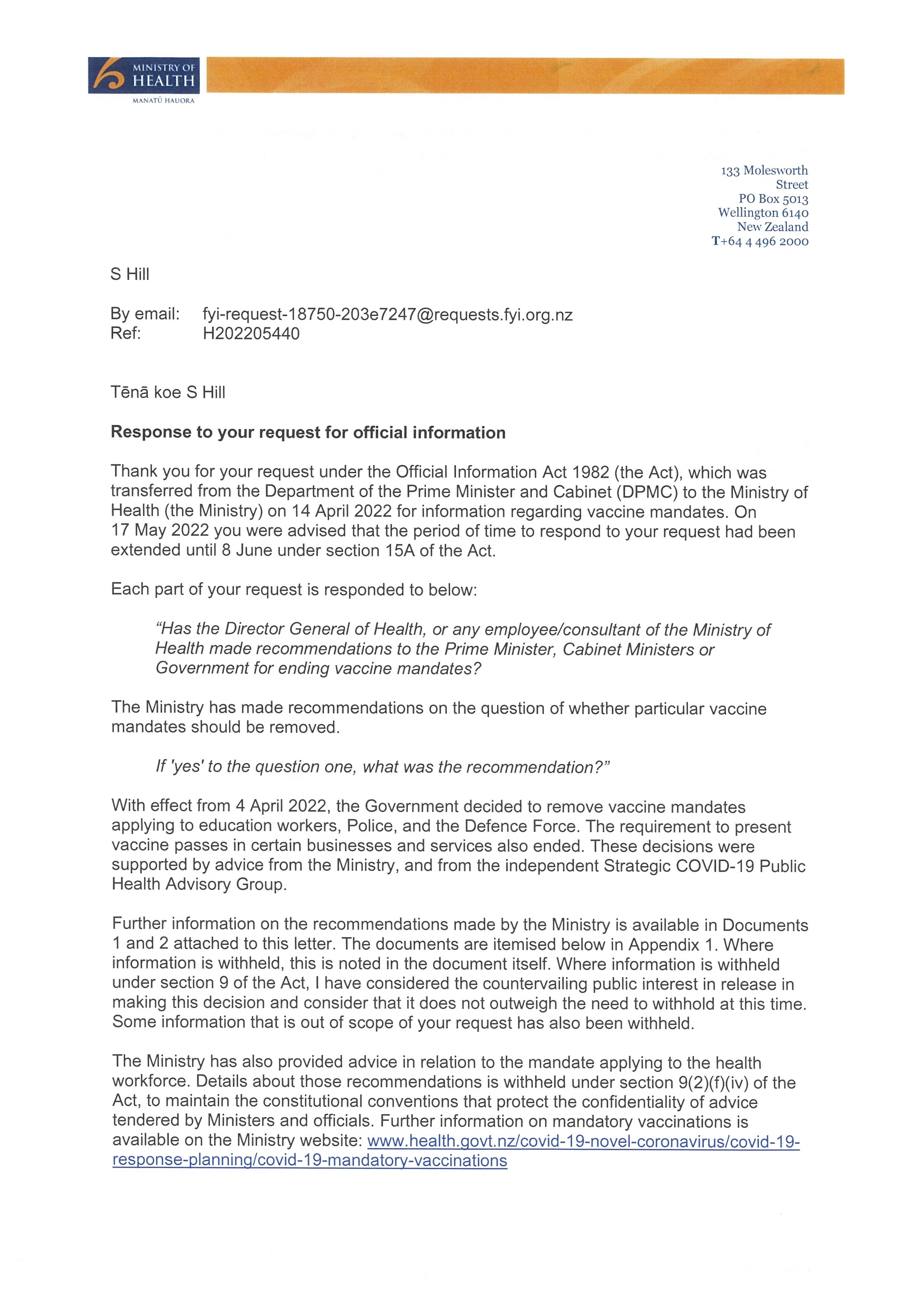
9 June 2022
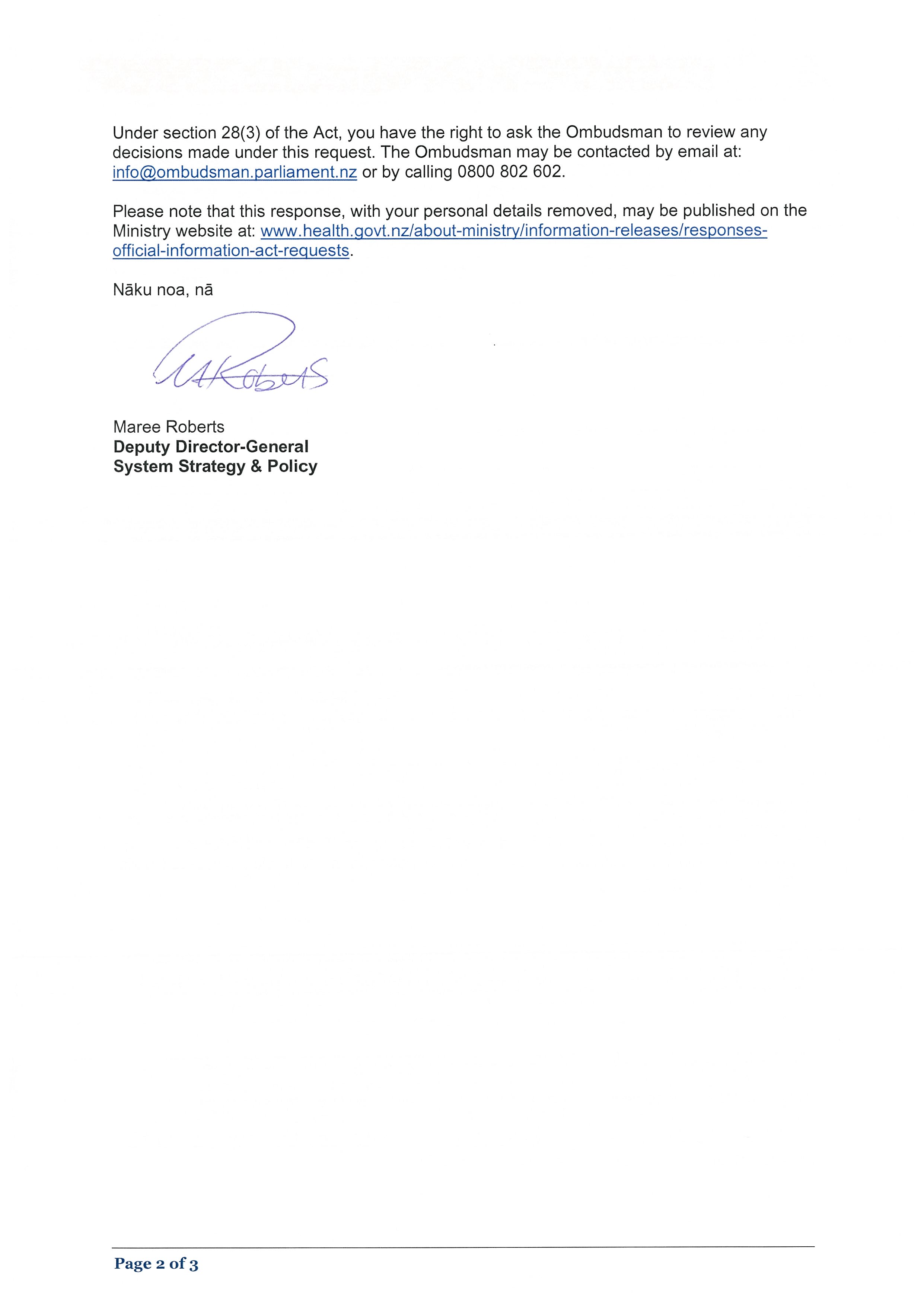
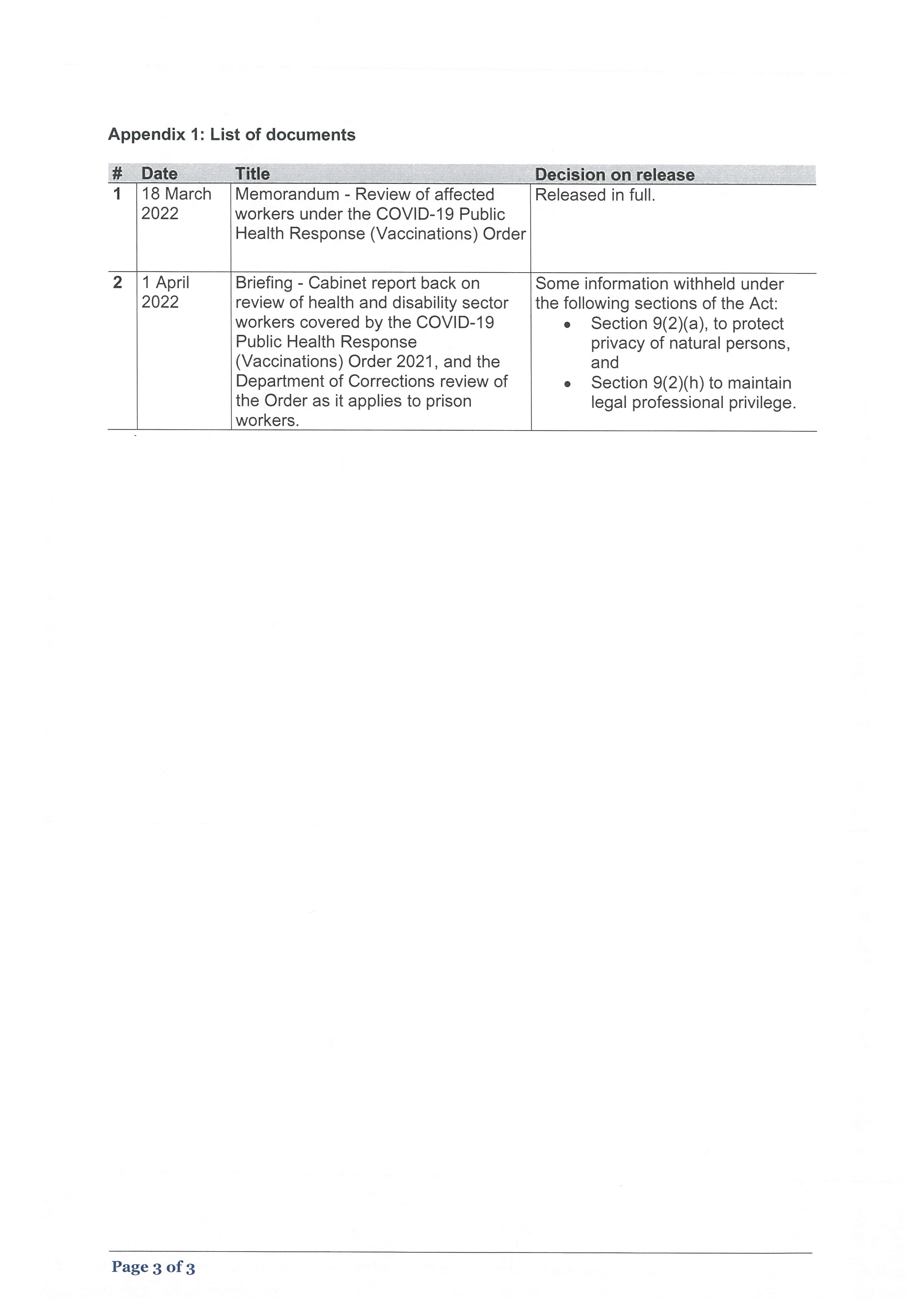

Document 1
Memorandum
Review of affected workers under the COVID-19 Public Health Response
(Vaccinations) Order
To:
Dr Ashley Bloomfield, Director-General of Health
From:
Stephen Glover, Group Manager, COVID-19 Policy
ACT 1982
Date:
18 March 2022
For your:
Consideration
Purpose
1.
This memo provides initial advice on the medium-term approach to the o
INFORMATION ngoing use of
vaccine mandates and required testing for specific workforces in line with the broader public
health approach post the peak of the Omicron outbreak.
Context
DPMC Cabinet Paper
2.
We have recently provided input into the Department of Prime Minister and Cabinet (DPMC)
Cabinet paper titled ‘The COVID-19 response for post-peak Omicron’ (to be considered by
Cabinet on 21 March). DPMC considered our advice alongside public health advice from the
Strategic COVID-19 Public Health Advisory Group, who were asked to review the worker
groups covered by the COVID-19 Public Health Response (Vaccinations) Order 2021 (the
Vaccinations Order).
3.
The Cabinet paper proposes to remove the requirement for Education workers, and implicitly
removes Group 10 workers (those workers who work in workplaces where a COVID-19
Vaccination Certificate is required to enter) to be vaccinated from the COVID-19 Public Health
Response (Vaccination) Order 2021, once the Omicron peak has been reached. It also includes
RELEASED UNDER THE OFFICIAL
advice that health workers should remain covered until after winter.
4.
We note that while we support these recommendations for the most part, we wil be
reviewing the settings for ECE workers as there may be a case to maintain an ongoing vaccine
mandate for this workforce. This is due to children 4 years old and under not being
vaccinated.
5.
We also committed to providing further advice about ongoing use of vaccine mandates, by
27 June and then 26 September unless changes are proposed earlier. We are considering the
ongoing use on the mandates sooner rather than later in the context of a rapidly shifting

Document 1
landscape and in the context of new information on how progress under the mandates is
tracking. This paper also considers the vaccination mandates in the context of the COVID-19
Public Health Response (Required Testing) Order 2021 and other relevant public health
mitigations for these workforces.
6.
The DPMC Cabinet paper also signals a new strategic approach to manage the ongoing
situation as we prepare to enter post peak settings, including:
•
Minimise the impact by ensuring high rates of up-to-date vaccination - Continue
promoting and delivering vaccines including further boosters if indicated to reduce the
risk of infection and transmission and minimise the severity and impact of COVID-19
infections.
•
Support the health system to cope with both residual baseline and potentia
1982 l
surges in demand – this includes reducing the pressure on the health system as much
as possible by empowering the majority of the New Zealand population to self-
ACT manage
COVID-19 and targeting resources carefully.
•
Focus resources on those most at risk – by targeting resources very carefully, we are
also conserving resources for those most at risk of severe health outcomes, which also
helps us fulfil our equity and Treaty of Waitangi responsibilities.
Current state/data for relevant worker groups
7. Due to the recommendations in the DPMC paper for Education and Group 10 workers to
INFORMATION
be removed from the Order, this paper wil provide up-to-date information and analysis for
the remaining key groups of workers in the health care, border and Corrections workforces.
8. We have obtained up to date data on the vaccination status of these key workforces to
consider:
OFFICIAL
Worker
Percentage (currently Percentage who
Percentage not Percentage due
groups
working) who have
have received 1 x
yet due
booster and
THE
received 2 x primary
boosters
booster dose
yet to receive
doses
Health care
100%
93%
Of the 7% not
exact figures
workers
boosted many
unknown2
UNDER
(DHBs)1
not due yet
(exact figures
unknown)
RELEASED
1 We only have data for all healthcare workers in the 20 nationwide DHBs as we are not able to obtain up-
to-date vaccination data from the other healthcare sectors at this time therefore the data for this workforce
is representative only – DHBs workers potentially carry some of the greatest risk. DHB workers represent up
to 40% of the overall health workforces.
2 Not all workers are eligible for their booster as at 14 March 2022. Others not boosted are covered by
Significant Service Delivery Disruption exemptions so are still at work. Out of over 92,000 total workforce,
only 222 have either been stood down due to vaccination status or are on extended leave for other reasons.
1
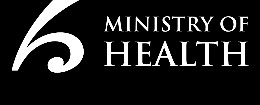
Document 1
Frontline
100%
85%
13.2%
1.4%
Corrections
workers
Al border
100%
93%
7%
0%
workers
9.
Of those workers yet to receive their booster dose, al 7% of outstanding border workers are
not yet due their booster, and 13.2% of Corrections workers are not yet due. Of those
Corrections workers who are due and have not yet received their booster, most are either off
1982
work for other reasons or are yet to have their booster recorded. Less than 20 people have
been removed from frontline duties due to being overdue their booster.
ACT
10. We can see from these numbers that vaccinations rates among these worker groups are very
high, and without further requirements for additional booster/vaccine doses, the mandates
wil shortly no longer serve a purpose as they stand.
11. This paper wil outline any potential rationale for ongoing use of the mandates, the risks
including the legal risk, and any alternative options to assist employers to maintain the up-
to-vaccination status of their workforces.
INFORMATION
Analysis
Change in risk profile
12. Vaccine mandates were enacted with a clear public health rationale to provide personal
protection against COVID-19 to workers in high-risk settings (such as border and health care
OFFICIAL
workers), and to help prevent transmission between workers and to vulnerable people to
whom they have a duty of care (health care, education and prisons), or to those in public
facing roles.
THE
13. Omicron is now spreading widely in the community, and based on modelling, is likely to be
near its peak. For most people it wil cause milder il ness than earlier variants, as it is more
transmissible and the vaccinations are less effective at reducing transmission. Our intent to
UNDER
maintain broad population protection with high vaccination uptake remains, with the focus
moving to providing personal protection to reduce health impacts and hospitalisations,
rather than a strong focus on reducing transmission.
14. The vaccination requirements in the Order represent a limitation on the right to refuse
medical treatment for affected workers. These requirements were shown to be reasonable,
justified and propo
RELEASED rtionate in the circumstances under which they were enacted. Given the
change in the risk profile now that we have a highly vaccinated population and widespread
Omicron, careful consideration of the ongoing limitation on BORA rights and the
proportionality of mandates is required.
15. Given the changes in the strategic context, we have assessed the ongoing use of vaccine
mandates and the associated use of required testing for border workers. The intent is to
provide an initial view on whether these are the most effective tools to help fulfil the strategic
objectives, and when we should be looking to remove any mandates entirely.
2
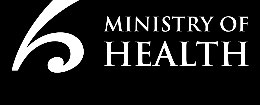
Document 1
Additional COVID-19 vaccine doses:
16. International evidence is emerging that immunity gained from booster doses also wanes in
a similar timeframe as immunity from primary doses wanes. Therefore, consideration is
currently being given to the potential need to rol -out additional boosters, (or a fourth dose)
across the population.
17. This work is progressing and is likely to propose fourth doses as other countries such as UK,
US, Sweden, and Israel have done. Their use is likely to initially focus on protecting
populations that are at higher risk, including the elderly, Māori and Pacific peoples, and will
need to consider the context over the coming months as the Omicron outbreak peaks and
tails off, with a large proportion of the population having been recently exposed to COVID-
19 infection and therefore having gained some natural immunity.
1982
18. We propose that any guidance and enforcement around vaccine mandates wil need to reflect
up to date guidance around when people should be vaccinated post-infection (cur
ACT rently 3
months).
19. Should fourth doses be considered essential for the health, Corrections, and border
workforces, consideration needs to be given to whether the mandates continue to be the
most appropriate and proportionate tool to achieve uptake, or whether other employer-
based, or public health measures would be more proportionate.
20. Beyond fourth doses, the World Health Organisation (WHO) has urged pharmaceutical
companies to prioritise progressing longer lasting and more effective COVI
INFORMATION D-19 vaccines.
Therefore, the vaccine landscape beyond fourth doses is unknown, but the focus wil remain
on workers here maintaining their up-to-date vaccination status.
21. To maintain justification for the vaccination order, amendments would be required that state
workers must maintain an up-to-date vaccination status, and that includes fourth doses (at
OFFICIAL
the appropriate dose interval), and any doses beyond.
22. This could only be justified if there is a clear public health rationale for the need for fourth
THE
doses (or any further doses to maintain vaccination status), in the context in which the Order
is amended. For example, the context would is likely to include:
• a continuing widespread outbreak (or risk of an outbreak from a new variant of concern)
UNDER
• evidence of the importance of fourth doses for the affected workforces
• evidence of further waning immunity, and
• evidence of increasing hospitalisations in groups beyond the expected vulnerable
groups (such as elderly, people with co-morbidities - for which targeted additional
vaccination could more appropriate).
RELEASED
23. We note that if we were to maintain the ongoing use of vaccine mandates, we would also
review the ongoing coverage of affected workforces. This would include consideration of ECE
workers.
Options for maintaining up-to-date vaccination status
24.
Option one – amend the current Vaccination Order requirements to maintain an ‘up to
date’ vaccination status: This option would set a legal requirement for consistent coverage
in workforces where that is deemed appropriate.
3
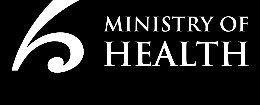
Document 1
25. Based on current analysis, we believe there is limited value in maintaining vaccine mandates
as they stand, particularly once the booster requirement is fulfil ed. At this point, the intent
of increasing vaccine uptake to protect vulnerable populations and maintain personal safety
wil have been fulfil ed, and any legal grounds for the mandates remaining in their current
form will be difficult to defend.
26. For most workforces, the date by which boosters wil be required (in al but exceptional
circumstances) is close. These timeframes have been effective in increasing booster uptake
in these populations, as set out in the table at para 7 above.
27. By updating the definition, this would ensure high levels of ongoing vaccine coverage among
a workforce where most people have agreed to be vaccinated. However, this would need to
be justifiable over less onerous provisions (see option 2 and 3). While there is a strong
1982
ongoing case for requiring high levels of vaccination for the particular workforces, there will
need to be careful consideration around the ongoing use of these measures and whether
ACT
this can be resolved by narrowing the scope of this mandate.
28.
Option two – support employment based contractual responses for workers at risk:
Once all workers (or as high a percentage as possible) in these workforces have received their
booster doses, any new employees coming into these sectors could be captured by
employment contractual requirements for vaccinations. This would shift the responsibility for
setting vaccine requirements to the employer. Employers could set these requirements
informed by health and safety assessments using updated guidance developed and provided
INFORMATION
by MBIE, WorkSafe and the Ministry of Health.
29. There is precedent for these approaches with certain health care workers currently being
subject to other contractual vaccination requirements for vaccines such as TB, MMR and
others. Outside of these workforces, Defence personnel are subject to a list of vaccination
requirements before they can enlist in the forces.
OFFICIAL
30. The DPMC Cabinet paper notes that the Ministry of Business, Innovation and Employment
and WorkSafe will update guidance for businesses, workers and unions to reflect the removal
THE
of government vaccination mandates and use of My Vaccine Pass. This wil emphasise that
businesses need to consider any ongoing restrictions under the Health and Safety at Work
Act framework, normal employment law obligations and any other relevant legislation.
Employers / PCBUs wil need to
UNDER update any risk assessments they have undertaken to reflect
updated public health advice on residual risks that businesses need to manage. This will
need to reflect a clear public health rationale that we wil work with them on.
31.
Option three – targeted public health approach for these worker groups: Prior to the
pandemic, sections of the health workforce, for example, have always had certain
vaccinations such as MMR and TB highly recommended for them to have prior to entering
RELEASED
the workforce, or to work in certain settings.
32. This approach could be rol ed out more widely to more workforces with clear
communications and public health messaging, and alternative means of incentivising uptake.
Lessons learned from the COVID-19 vaccination roll out of the approaches that have made a
difference to uptake include:
• Decrease in travel time to access vaccination (interaction with more deprived regions)
• Increase in delivery site capacity
4
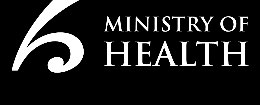
Document 1
• Marketing – e.g. vaxathon or other local events
• Targets- e.g. 90% regional targets motivated people in neighbourhoods (we lack current
target for boosters).
33. These methods can be adapted to different workplaces, workforces and across regions.
Workplace-based delivery of vaccinations, so that employees can easily book and receive
their vaccinations during work time, has also been shown to be highly effective, for both
COVID-19 and annual influenza vaccines.
34. Other ‘test to work’ options can also be utilised alongside the public health approach such
as RAT testing to ensure employees are not currently infected, as well as new COVID-19
immunity testing devices available to test current immunity levels.
1982
Required Testing Order
ACT
35. We have also considered the ongoing use of the Required Testing Order, however we note
that this needs to be aligned to decisions around the ongoing use of the Vaccine Order for
Border Workers, as well as the ability to fulfil the most recent advice on testing and
surveil ance.
36. Based on internal consideration, it is considered that there is no longer a public health
justification for the RTO now that border workers are currently at no greater risk in their work
setting than in the community, for both the risk of Omicron and any new variant. Now that
INFORMATION
MIQ requirements have been removed, it is considered more likely that a traveller will bring
any new variant into the community than a border worker.
37. Essential y, both orders depend on the same public health rationale that they are there to
protect against new variants at the border. With the phased re-opening of the border, the
number of people crossing the border and entering the community without entering
OFFICIAL
isolation diminishes the ongoing value of identifying cases through regular worker testing
diminishes. At this scale, surveil ance testing at the border (including surveil ance testing of
THE
international arrivals) is likely to be more effective at early detection, particularly where this
includes testing of symptomatic cases and confirmatory PCR testing to enable Whole
Genome Sequencing.
38. Based on the proposed review
UNDER of the Vaccine Order and recent advice on strengthening
testing and surveil ance settings, we wil look to review the ongoing use of the Required
Testing Order to ensure that it is the appropriate mechanism for testing and surveil ance at
the Border and enables ongoing surveil ance and testing over the next three months,
although it is likely that we wil need to reduce the workforce coverage based on assessment
of public health risk.
RELEASED
Next steps
39. Pending your agreement, we wil provide more comprehensive advice on changes to the
Vaccinations Order to reflect the change to require an up-to-date vaccination status and the
removal of border workers from this group. This will also include advice on based on a review
of workforces covered by the Vaccine Order (including ECE workers).
40. We wil seek further legal analysis to inform this advice, including engaging with Crown Law
on the Bill of Rights Act implications.
5
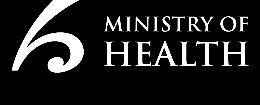
Document 1
41. We wil also provide further advice on the Required Testing Order informed by decisions in
this paper and advice on testing and surveil ance settings.
42. Additionally, COVID-19 Policy will lead work with WorkSafe, the Ministry of Business,
Innovation and Employment to develop enhanced guidance for workforces who have been
previously covered by the Vaccination Order on potential ongoing requirements and options
to maintain up-to-date vaccination status for higher risk workforces.
Recommendations
It is recommended that you:
a)
Note that this advice is intended to support potential discussion at Cabinet
Noted
on 21 March on the ongoing use of the COVID-19 Public Health Response
(Vaccinations) Order 2021 (the Vaccination Order)
ACT 1982
b)
Note that Vaccination Order has been effective in supporting high levels of
Noted
booster uptake in the affected workforces to date, but the high uptake cannot
be attributed solely to the mandates.
c)
Note that once affected workforces have met their booster requirements
Noted
(very soon), the ongoing use the Vaccination Order in its current state, it will
be chal enging to argue that there is a justifiable public health rationale.
INFORMATION
d)
Agree to develop advice to the Minister for COVID-19 response to present
the following options:
1) Update the Vaccination Order to reflect a requirement to maintain an
Yes/No
up-to-date vaccination status for the workforces currently covered by
the Vaccination Order (noting that Education and Group 10 workforces
may no longer be included), and this will include fourth, and any
further doses.
2) Once the affected workforces meet their booster requirements,
Yes/No
remove the Vaccination Order, noting that this wil be before the end
of Winter 2022, and provide appropriate guidance for employers to
maintain contractual requirements for vaccination and public health
measures to support ongoing high levels of vaccination.
3) Once the affected workforces meet their booster requirements,
Yes/No
remove the Vaccination Order, and work to support the affected
workforces to implement a public health based, non-mandatory
approach to vaccinations including supporting ease of access to
vaccines and workplace testing
RELEASED UNDER THE OFFICIAL
4) A combination of options 2 and 3 based on the most appropriate
Yes/No
approach for each workforce currently under the Vaccination Order.
e)
Note we would review workforce coverage under the Vaccination Order if it
Yes/No
is to remain in force to ensure that coverage is limited and commensurate
with the public health intent, including:
6
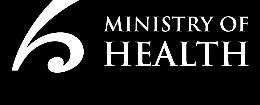
Document 1
• the Border workforce
• the Health workforce (including disability and aged care workers)
• and ECE workforce.
f)
Note that the System, Strategy & Policy group will lead work to review the
Noted
ongoing use of the Required Testing Order to ensure it remains fit for purpose,
pending decisions on the ongoing role of the Vaccination Order and advice
on the role of testing and surveil ance at the border.
g)
Note that System, Strategy & Policy and COVID-19 Health System
Noted
Preparedness directorate wil work with the Ministry of Business, Innovation
1982
and Employment, WorkSafe on guidance to support high ongoing levels of
vaccine uptake for groups no longer covered by the vaccine mandate.
ACT
h)
Note that in the development of this more comprehensive advice we will
Noted
consult with Crown Law
.
Signature____________________________________________________
Date: 18 March 2022
INFORMATION
Dr Ashley Bloomfield
Te Tumu Whakarae mō te Hauora
Director-General of Health
OFFICIAL
THE
UNDER
RELEASED
7

Document 2
Briefing
Cabinet report back on review of health and disability sector workers
covered by the COVID-19 Public Health Response (Vaccinations) Order
2021, and the Department of Corrections review of the Order as it applies
to prison workers.
Date due to MO: 1 April 2022
Action required by:
1 April 2022
Security level:
IN CONFIDENCE
Health Report number: 20220593
ACT 1982
To:
Hon Chris Hipkins, Minister for COVID-19 Response
Copy to:
Hon Andrew Little, Minister of Health
Contact for telephone discussion
INFORMATION
Name
Position
Telephone
s 9(2)(a)
Dr Ashley Bloomfield
Te Tumu Whakarae mō te Hauora
Director-General of Health
Maree Roberts
Deputy Director-General, System Strategy
and Policy
Minister’s office to complete:
☐ Approved
☐ Decline
☐ Noted
☐ Needs change
☐ Seen
☐ Overtaken by events
RELEASED UNDER THE OFFICIAL
☐ See Minister’s Notes
☐ Withdrawn
Comment:
Document 2
Cabinet report back on review of health and disability sector
workers covered by the COVID-19 Public Health Response
(Vaccinations) Order 2021, and the Department of Corrections
review of the Order as it applies to prison workers.
Security level:
IN CONFIDENCE
Date:
1 April 2022
To:
Hon Chris Hipkins, Minister for COVID-19 Response
Copy to:
Hon Andrew Little, Minister of Health
1982
Purpose of report
ACT
1.
This briefing provides you with the draft report back requested by Cabinet on a review of
the health and disability sector workers covered by the COVID-19 Public Health Response
(Vaccinations) Order 2021 (the Order), and also includes the report back requested of the
Department of Corrections on their review of the Order as it applies to prison workers.
[CAB-22-MIN-0086].
Context
INFORMATION
2.
On 21 March 2022, noting public health advice from the Strategic COVID-19 Public Health
Advisory Group (SPHAG) recommended retaining workers at higher risk of exposure and
transmission of COVID-19 under the Order, Cabinet agreed to retain the following
workforces and review the Order again by 27 June 2022 and 26 September 2022:
OFFICIAL
a. Health and disability sector workers (which includes aged care workers),
b. Prison staff, and
THE
c. Border and MIQ workers.
3.
Cabinet directed the Ministry of Health (the Ministry) to report back by early April on a
review of the health and disability sector workers covered by the Order, with a view to
UNDER
narrowing the workers to which it applies, if appropriate. Cabinet also directed the
Department of Corrections to report back by early April on a review of the Order as it
applies to prison workers.
Draft Cabinet paper 4.
The Ministry has pre
RELEASED pared the attached draft paper for your review and feedback prior to
lodging with the Cabinet Office. You may also wish to consult with Ministerial colleagues
on the contents of the draft submission.
5.
The paper notes that the Ministry has reviewed the health and disability workers covered
by the Order with particular reference to different workplace settings, the risk of exposure
to and transmission of COVID-19 in those settings compared to in the broader community,
and the face to face nature of the work in those settings.
Briefing: 20220593
1
Document 2
6.
Following the review, the Ministry considers there is still a high risk for workers who work
directly with people who may have COVID-19 or people who are at high risk of severe
outcomes from COVID-19 and for those who work directly in aged care or with vulnerable
and/or disabled people.
Analysis undertaken
7.
When undertaking the review we considered the option of leaving all currently affected
workers under the Order through winter 2022. This option considered the fact that all
currently affected workers can at times be onsite in high risk settings and interacting with
vulnerable people. We assessed whether it would be possible to clearly separate out
categories of workers with a different risk profile from other affected workers under the
Order.
8.
Given the change in the risk environment with Omicron circulating widely, and the key
assessment factor to consider the risk at work compared to out in the broader community,
we concluded there were some groups for whom there is no longer a clear public health
ACT 1982
rationale to meet the threshold of being reasonable and justified that they remain in the
Order. These groups include those workers for whom being onsite at health or disability
premises is incidental to their core work as set out in the Cabinet paper.
9.
Additionally, we considered the group “health practitioners” captured under clause 7.1 of
Schedule 2, Part 7 of the Order, and whether this group could be refined as it currently
captures all practitioners under the Health Practitioners Competence Assurance Act 2003.
Assessing whether we could clearly separate out categories of workers in this group with
INFORMATION
a different risk profile from other affected workers under the Order, became problematic
when we took the following factors into account:
a. many clinicians who provide services in apparent lower risk settings, such as private
community clinics (compared to for example a hospital), perform mixed roles, also
spending time in hospitals, aged care facilities or in private homes
b. secondly many vulnerable or immunocompromised people are currently avoiding
public spaces and being out in the community due to the Omicron outbreak, but they
cannot avoid attending health or disability services which are essential to their
wellbeing. All health practitioners provide services to a range of vulnerable people
and we need to ensure these patients/clients are not being put at higher risk by
attending appointments or receiving these services. It is not possible to determine if
vulnerable people are more likely in one setting over another.
10.
The third (and preferred) option we considered was whether the groups of workers
currently captured by clauses 7.2 and 7.3 of Schedule 2, Part 7 of the Order could be
refined, as they currently cover some workers for whom the risks of contracting and
transmitting COVID-19 are no longer higher at work than in the broader community.
RELEASED UNDER THE OFFICIAL
11.
We concluded they should be refined and the proposed amendments are set out in the
paper. The proposed amendments will likely result in the removal of some workers from
the Order such as Police, social workers, external maintenance contractors, some ‘back
office’ functions and others who are currently captured, but for whom being onsite at
health or disability premises is incidental to their core work.
12.
Clause 7.4 “care and support workers” has also been identified as causing potential
confusion for employers. While amendments to this category is not recommended at this
time, the Ministry will review any guidance provided to employers on how to interpret the
Briefing: 20220593
2
Document 2
“care and support worker” category, to see if further guidance can be provided that will
clarify the application of the Order to this group.
Looking ahead
13.
In general COVID-19 vaccination remains highly recommended for all workers, regardless
of their workplace setting, and those workers who will no longer be covered by the Order
could still be covered by employer based vaccination requirements.
14.
The Ministry of Business, Innovation and Employment and WorkSafe New Zealand have
updated their guidance, in consultation with the Ministry of Health, for employers no
longer covered by vaccination orders.
15.
s 9(2)(h)
ACT 1982
16.
For prison workers affected by the Order, Corrections officials are completing a risk
assessment for COVID-19 in prisons and will provide advice to Ministers in late May 2022
on the ongoing need for prison workers to be included under the Order. The paper
includes an update on progress towards the assessment.
Risks
INFORMATION
17.
The risk that COVID-19 poses in terms of serious health impacts, hospitalisations, deaths,
and overall pressure on the health system, (including the impact on staff and service
delivery) remains. With the Omicron variant still widespread in the community
transmission will continue for some time to come.
18.
Recent public health advice from the Strategic COVID-19 Public Health Advisory Group
(SPHAG) recommended retaining workers at higher risk of exposure and transmission of
COVID-19 including from new variants under the Order.
19.
The public health risk was considered for all health and disability sector workers in terms
of the risk to themselves and those to whom they have a duty of care, of contracting or
transmitting COVID-19 in the workplace, compared to the risk in the broader community.
20.
To mitigate the risk that COVID-19 still poses in many settings it is recommended to retain
workers in high risk settings such as those who work directly with people who may have
COVID-19, or people who are at high risk of severe outcomes from COVID-19, and those
who work directly in aged care or with vulnerable and/or disabled people.
21.
The workers who may be removed from the Order will be those for whom the risk is no
greater in the workplace (or at work) than in the broader
RELEASED UNDER THE OFFICIAL
community, and for whom being
in health and disability setting is incidental to their core work.
s 9(2)(h)
Briefing: 20220593
3
Document 2
s 9(2)(h)
Equity
25.
We know COVID-19 has disproportionately affected Māori and Pacific peoples. Keeping
the Order in place for the health and disability workers in the highest risk settings will help
to protect Māori and Pacific people who are in roles affected by the Order, and Māori and
ACT 1982
Pacific peoples accessing health and disability services.
26.
We acknowledge there may be employment implications for unvaccinated Māori and
Pacific peoples hoping to enter the health and disability sector, impacting on their
employment options, and therefore the income of their households. The proposal to refine
the groups captured by clauses 7.2 and 7.3 may reduce these implications.
27.
Keeping the Order in place for the relevant health and disability workers for now will also
have a positive effect on the disability community, and other vulnerable people, to help
INFORMATION
protect them as they interact with health and disability services.
Next steps
28.
We invite you to forward the paper to any other Ministers you consider necessary for
consultation, to be completed by 6 April 2022.
29.
Once you have provided your feedback on this draft paper, a final version will be prepared
for your signature and lodging with the Cabinet Office by 10am Thursday 7 April 2022.
RELEASED UNDER THE OFFICIAL
Briefing: 20220593
4


Document 2
30.
Recommendations
I recommend you:
a)
Note the draft report back on a review of the health and disability sector workers
Noted
covered by the COVID-19 Public Health Response (Vaccinations) Order 2021 (the
Order), and also the report back requested of the Department of Corrections on
their review of the Order as it applies to prison workers.
b)
Agree to consult on the paper with any other Ministers you consider necessary,
Yes/No
with a deadline of 9am Wednesday 6 April 2022 for comments.
c)
Note the deadline to lodge the final paper is 10am Thursday 7 April 2022.
Noted
ACT 1982
INFORMATION
Dr Ashley Bloomfield
Hon Chris Hipkins
Te Tumu Whakarae mō te Hauora
Minister for COVID-19 Response
Director-General of Health
Date:
Date:
4/4/2022
RELEASED UNDER THE OFFICIAL
Briefing: 20220593
5
Document Outline













